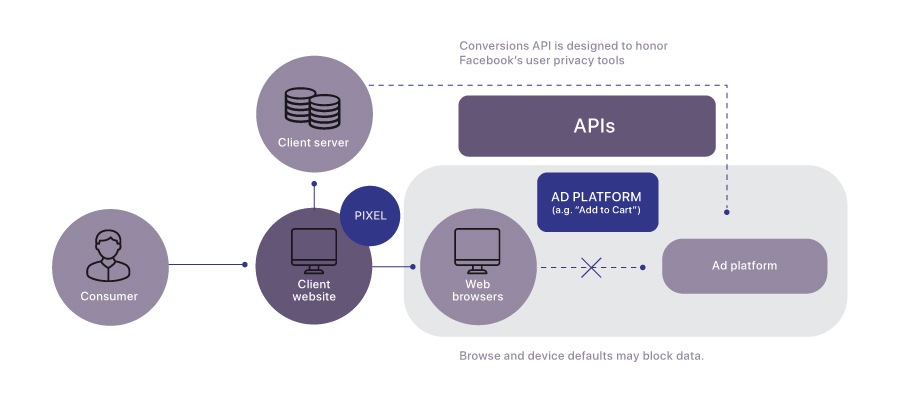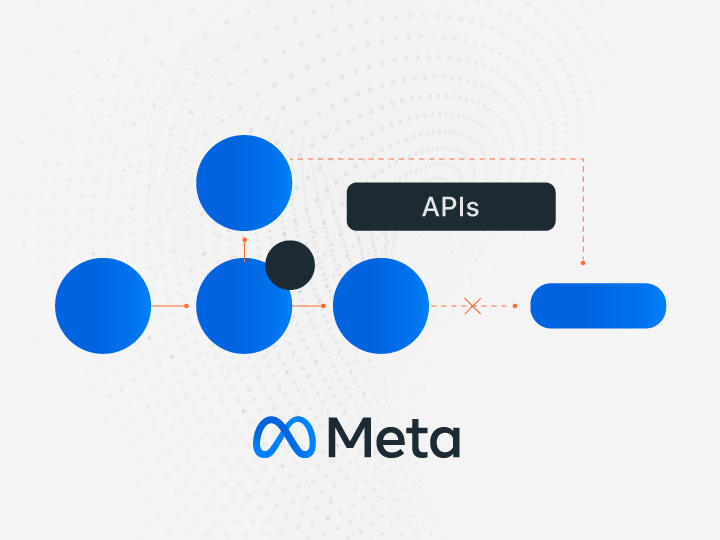WHAT IS META CONVERSION API?
The Conversion API is Meta’s solution to the changes that are about to be presented or that already exist, regarding the recording of data in the digital world. By using this method, the events that Meta needs in order to optimize advertising campaigns, are transferred directly to the platform itself from our Server.
It’s currently used in combination with your Meta Pixel to ensure you’re getting all the data you need. After these two tools are additionally used, Meta undertakes to deduplicate the results, so that no duplicates are recorded, resulting to a negative impact as far as data quality is concerned.
What is the problem with Meta Pixel?
Meta Pixel is now recording less data due to Ad Blockers, cookie blockers, and the iOS 14 upgrade implemented by Apple. This upgrade results in a large restriction on recording through cookies on mobile devices.
In other words, if a user visits the e-shop / website using iOS software it is very likely that the data will not be recorded. The data limitation will negatively affect the size of Custom Audiences and Retargeting Audiences.
How do I install it?
The installation of CAPI can be done in different ways depending on the case but a basic condition in whichever way we choose is to implement domain verification in Meta.
Domain verification helps you secure the rights to manage your business domain in both organic and paid content. Once we have activated domain verification then we can choose the way we want to install CAPI.
The alternatives to its installation are 4 and are as follows:
- Installation through partner trading platforms: As long as you use a trading platform, which cooperates with Meta, you have the ability to make the connection with just a few clicks. Indicative commerce platforms that partner with Meta are WordPress, Shopify, Magento, PrestaShop, and more.
- Conversion API portal: Installation through the conversion API portal does not require code and is done through event management.
- Integration of other partner platforms: If your business website is located on one of the platforms that partner with Meta, such as Google Tag Manager (GTM), Tealium or someone else, then the opportunity to integrate directly through the partner platform is given.
- Direct integration using code: This option requires developer’s integration as greater control over the process is achieved.
Post-installation monitoring and continuous improvement
Having completed the installation of the Conversion API, an important point is the continuous monitoring of events and the corresponding parameters. This monitoring tactic enables you to ensure its effective and accurate operation and pinpoint room for optimization.
Control steps
- Use the tool offered by Meta to check if events are working properly.
- Check the rate at which data is refreshed (Data Freshness). In order not to affect the efficiency of advertising campaigns negatively. It is important to transfer events in less than 24 hours from the server to Meta.
- Ensure that events transferred to Meta are in excess quantity. Sharing additional events with Meta is considered a best practice. This information on redundant events can be viewed from the Event Overview option.
- An important point is the control and optimization of the process of checking duplicate events by Meta (Event Deduplication). Events that are the same and sent by the Meta Pixel and through the Conversion API need to be processed by the platform itself so that they are not recorded twice but once since they are identical.
- Moreover, you must emphasize the option of Event Matching. This tab shows us the matching quality of events compared to other advertisers. High-quality event matching results in a reduction in cost per result.
- Another important point is the Diagnostics field. When you are transferred there, you will find possible challenges with the interconnection and transfer of data through the Conversion API to Meta and possible solutions to these problems.
Stay up to date with the latest Digital News!
CONTACT US


